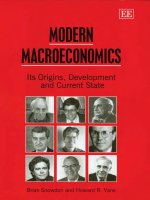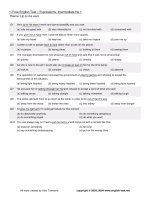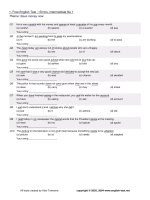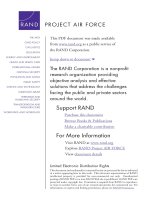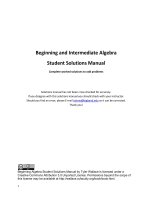Intermediate macroeconomics chapt04
Bạn đang xem bản rút gọn của tài liệu. Xem và tải ngay bản đầy đủ của tài liệu tại đây (624.03 KB, 39 trang )
Chapter 4:
Money and Inflation
Functions of Money
Medium of Exchange
Store of Value
Unit of Account
Standard of Deferred Payment
Types of Money
Commodity money: a commodity with some
intrinsic value used as a medium of exchange
(e.g., cigarettes in POW camps)
Fiat money: a commodity with no intrinsic value
established by a government decree as money
(e.g., coins & bills)
Characteristics of Money
Limited in supply
Widely accepted
Portable
Divisible
Uniform
Durable
Money Supply
M1
– Currency: coins & bills (25%)
– Demand Deposits: checking account deposits (75%)
M2
– M1
– Time Deposits: savings account deposits less than
$100,000
Money Supply
M3
– M2
– Time Deposits: savings account deposits more
than $100,000
L
– M3
– Liquid assets (e.g., T-Bills)
The Measures of Money
C
M1
M2
M3
L
$434 billion in April 1998
$1,081
$4,165
$5,574
$6,826
Money Supply Line
The quantity of money in circulation is controlled
by the central bank in real value = M/P
Interest Rate (%)
(M/P)s
10
5
80
Quantity of Money
Money Demand
The amount of money demanded for transaction
and speculation purposes depends on personal
income and interest rate
At any level of personal income, quantity
demanded of money is a negative function of
interest rate
Money Demand Line
M/P = f(Y, r)
Y = income
r = real interest rate
Interest Rate (%)
10
5
(M/P)d
80
100
Quantity of Money
Money Market Equilibrium
Interest Rate (%)
(M/P)s
5
(M/P)d
80
Quantity of Money
Federal Reserve System, FED
The central bank of the U.S.
Independent decision making unit with regional
banks
In charge of money supply management and
economic stabilization
Tools of Monetary Policy
Legal reserve ratio: ratio of cash reserves to
deposits that banks are required to maintain
By lowering the ratio, banks will have more
reserves to lend and invest, increasing the money
supply
Tools of Monetary Policy
Discount rate: rate of interest the FED charges on
loans to banks
By lowering the rate, banks encourage borrowing
from the FED and lending to the public, increasing
the money supply
Tools of Monetary Policy
Open Market Operations: FED’s purchases and
sales of government bonds
By purchasing bonds and paying the sellers, the
FED increases the money supply
Expansionary Monetary Policy
Increase the money supply by any one or
combination of the above tools
Reduce the interest rate to encourage investment
Increase investment expenditures, thus creating
employment & income
Expansionary Monetary Policy
Interest Rate (%)
(M1/P)s (M2/P)s
5
4
(M/P)d
80 85
Quantity of Money
Quantity Theory of Money
Equation of Exchange: MV = PY
– M = money supply
– V = income velocity of money: the rate of
turn over of money
– P = general price level
– Y = output of goods & services
Income Velocity of Money
(M/P)d = kY where k is the percentage of money balances
held for transactions
Equilibrium (M/P)s = (M/P)d
M/P = kY
M/k = PY
So, V = 1/k
If k = 0.10, then V = 10: a $1 changes hands 10 time a year
Money Supply Growth & Inflation
In 1960s, inflation was low and money supply
growth constant at about 7%
In the 1970s, inflation rose as the money supply
grew at an increasing rate to reach 10%
In the 1980s and 1990s, inflation fell as money
supply grew at a declining rate to reach about 6%
Historical Data
International Data
Inflation
A continuous rise of the general price level
General price level is measured by the CPI or
GDP Deflator
Percentage change of the general price level over
the previous period
Inflationary Trend
Inflation stayed under 5% during the 1960s
It averaged 7.7% in the first half and 10.6% in the
second half of the 1970s
Since the early 1980s, inflation rate has declined
to as low as 3% in the late 1990s
Money and Inflation
Take percentage change from MV = PY
%ΔM * %ΔV = %ΔP * %ΔY
V = 1/k and Y at full employment are constant
%ΔM = %ΔP : a 1% increase in the money supply causes a
1% increase in the general price level

